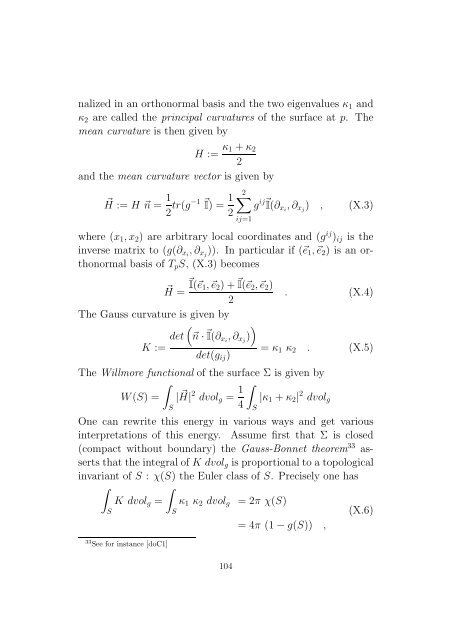Conformally Invariant Variational Problems. - SAM
Conformally Invariant Variational Problems. - SAM
Conformally Invariant Variational Problems. - SAM
Create successful ePaper yourself
Turn your PDF publications into a flip-book with our unique Google optimized e-Paper software.
nalized in an orthonormal basis and the two eigenvalues κ 1 and<br />
κ 2 are called the principal curvatures of the surface at p. The<br />
mean curvature is then given by<br />
H := κ 1 +κ 2<br />
2<br />
and the mean curvature vector is given by<br />
⃗H := H ⃗n = 1 2 tr(g−1 ⃗ I) =<br />
1<br />
2<br />
2∑<br />
g ij ⃗ I(∂xi ,∂ xj ) ,<br />
ij=1<br />
(X.3)<br />
where (x 1 ,x 2 ) are arbitrary local coordinates and (g ij ) ij is the<br />
inverse matrix to (g(∂ xi ,∂ xj )). In particular if (⃗e 1 ,⃗e 2 ) is an orthonormal<br />
basis of T p S, (X.3) becomes<br />
⃗H = ⃗ I(⃗e 1 ,⃗e 2 )+ ⃗ I(⃗e 2 ,⃗e 2 )<br />
. (X.4)<br />
2<br />
The Gauss curvature is given by<br />
( )<br />
det ⃗n·⃗I(∂<br />
xi ,∂ xj )<br />
K := = κ 1 κ 2 . (X.5)<br />
det(g ij )<br />
The Willmore functional of the surface Σ is given by<br />
∫<br />
W(S) = | H| ⃗ 2 dvol g = 1 ∫<br />
|κ 1 +κ 2 | 2 dvol g<br />
4<br />
S<br />
One can rewrite this energy in various ways and get various<br />
interpretations of this energy. Assume first that Σ is closed<br />
(compact without boundary) the Gauss-Bonnet theorem 33 asserts<br />
that the integralof K dvol g is proportionalto a topological<br />
invariant of S : χ(S) the Euler class of S. Precisely one has<br />
∫ ∫<br />
K dvol g = κ 1 κ 2 dvol g = 2π χ(S)<br />
S S<br />
(X.6)<br />
= 4π (1−g(S)) ,<br />
33 See for instance [doC1]<br />
S<br />
104
















